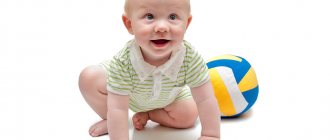One of the important motor skills of an infant is crawling on its belly. Movement on the stomach is, of course, not as symmetrical or correct as we are used to seeing in various scenes from life, but for children the movement itself is important. The skill is useful until a certain age, then all fours should take over. If a child begins to crawl on his belly, this indicates his good psycho-physical development, if we are talking about the age of about 5-6 months. The need to crawl is due to the child’s desire to explore the space around him, with all its contents. Almost all children begin to crawl on their stomachs, there are only slight differences in “styles”, some start sideways, some crawl backwards, some pull themselves up with their hands, etc. The period of crawling on the belly in babies usually lasts 1-2 months, then it is replaced by all fours, but there are also predecessors; first the child must learn to roll over onto his stomach. Moving on your stomach on the floor is a transition period between rollovers on your tummy and the pose of all fours. Therefore, as soon as the child begins to crawl on his belly, this means the beginning of the preparatory stage for getting up on all fours. Periodic lifting with straight arms, tucking your knees under yourself, pulling yourself up with your hands while sliding along the floor, all this strengthens the muscles, which is important for the next stage.
At what month does a baby begin to crawl on its belly?
All children begin to crawl one way or another. The age at which a child learns this may vary by up to several months. Most often, children begin to crawl on their bellies at 5-6 months. This is preceded by frequent turns in a circle while lying on your stomach. It must be said that delays in physical development are also common, and children who are not crawling can be 7-9 months old. It is advisable to work with this and the baby needs to be strengthened on time. If you want your child to do everything in his own time, then do a course of restorative massage with gymnastics at 3,6, 9, 12 months; it happens that it is required more often, but for most this is enough. A doctor's appointment for general strengthening exercises with massage is not necessary if the child does not have any diagnoses. If the baby has health problems, then you can check with the doctor that there are no contraindications, and then how to develop and what to teach the child is your choice.
When a child begins to crawl on his belly, he is driven by an interest in getting closer to the objects around him, but he can also simply explore the capabilities of his body. By 5-6 months, children are no longer ready to just lie down and look at everything around, they strive to move.
When does a baby start crawling?
The crawling reflex in children appears immediately after birth. This is easy to check - you need to put the baby on his stomach and place your palms on his heels, the child pushes off lightly and moves forward. These movements occur unconsciously, this is how an innate reflex manifests itself. It completely disappears by 3-4 months. At this age, the next stage of preparation for crawling begins. The little one already holds her head confidently and easily turns over from back to stomach.
At 5-6 months the first attempts to crawl appear. But let us immediately note that the development of each child occurs individually. Some people start crawling late, others earlier, and some skip this step altogether and immediately get to their feet.
The formation of motor activity in children depends on the following factors:
- health (presence of past or congenital diseases);
- the character and temperament of the baby;
- psychological weather in the family.
It is generally accepted that girls are ahead of boys in development, which is why they begin to crawl much earlier. This is wrong. Pediatricians confirm that the child’s gender does not have any effect on the ability to crawl.
Stages of crawling
Each baby has its own “manner” of crawling. But experts identify 3 stages that a child must go through in order to learn to crawl well. Let's look at each of them in more detail:
- 5-7 months – crawling on the stomach.
The baby has learned to roll over onto his stomach on his own and is trying to move forward with the help of his hands. Here there is an intense load on the shoulders and elbows. Most often, the baby moves to the side or backward.
- 6-8 months – crawling on your belly.
The baby pulls up his legs with all his might and tries to move forward. You have to lean on your palms, which greatly facilitates the movements themselves. At first the child will move backwards. There is no need to worry about this; this is normal. Over time, crawling on your belly will teach you to get up on all fours.
- 7-9 months – crawling on all fours.
When the baby learns to support his weight on all fours, he will begin to rearrange his arms and legs. It looks like swaying. At about 9 months, children already fully begin to crawl and actively move on all fours.
These stages are conventional, but most children go through them. Some children act in their own way, choose a more convenient way of moving and use it for a long time. Active children can skip the initial stages and go straight to all fours.
How to teach a child to crawl on his belly?
Unlike crawling on all fours, children are not taught to crawl on their bellies. The thing is, you can't practice motor skills here. Of course, you can use reflex crawling, but this is a reflex that will fade away, and a conscious effort is required from the child.
In order for the baby to crawl on his stomach, you need to provide:
- “physics” i.e. The child needs to be physically strengthened so that he has enough strength to move himself; in some cases, on the contrary, it is necessary to eliminate excessive tension in the muscles, hypertonicity, which can hinder movements.
- an environment that is favorable for the formation of a skill is a hard surface, a carpet on the floor, and not parental pyrinas.
- “psyche” i.e. At first, you can lure the child with toys and place them at a distance to motivate the child.
Practice shows that children master crawling on their bellies faster if they are laid on the floor from 3-4 months; this is also useful for turning over. How to teach a child to crawl on his belly? You just need to prepare him for this, as described above, the main thing is physical readiness and location.
What is better: crawling or walking straight away?
Crawling is an integral part of a motor skill in mastering the surrounding world; if a child does not stand on his feet, it means that his bone corset is not yet fully strengthened. You cannot put a child on his feet by force, seeing how difficult it is for him to support his own weight, this can damage the fragile spine. Nobody teaches children to crawl; they choose the easiest ways to move: on all fours - when the arm muscles are stronger, spider-like with outstretched legs and supported on the elbows - when the leg muscles are stronger, on the bellies - when the child still finds it difficult to maintain balance. This suggests that the cerebellum is not yet working at full capacity, and children who crawl on their bellies necessarily then begin to “walk” on all fours and, moreover, they stand on their own feet and try to take their first steps without the help of adults. As they say, there is a time for everything: when the center of balance turns out to be “capable”, then the child will begin to master more complex movements.
Parents' mistakes
Not every child crawls on their bellies, pressing their body to the floor. This is new to many parents; they cannot understand what prevents the child from kneeling, so they themselves begin to correct his movements, which is strictly prohibited. Think for yourself: if the child himself cannot master a simple skill, then it will not be possible for him to move on to a more complex one on his own. The child must master the world around him, navigate the room, recognize objects not only visually, but also by touch - these are all part of the movements that can be performed by the baby in any way.
If a child at 7,8,9 months crawls on his belly.
In general, from 7 months it’s time for the baby to master all fours, i.e. By this time he should already be crawling away on his stomach for about 2 months. The physical capabilities of infants at this age are not at the same level for everyone, but for this there is massage and gymnastics. If a child has a delay in motor development, then it is advisable for a massage therapist to work with him, it is better, of course, if it is on time, i.e. a course of massage with gymnastics at 3 and 6 months, then most likely there will be no delays.
We remember that for babies with “aggravating circumstances” such as prematurity, illness, surgery, etc., we need to make allowances and not overload them with all kinds of developmental items.
The child may be lazy and not want to put too much strain on himself, especially if his mother gives him everything and takes him in her arms at the first peep. But practice shows that after a course of strengthening gymnastics, even overly calm children become more active, new skills appear, in a word, progress in development. Therefore, if a child at 7,8,9 months is still crawling on his belly, then take measures to strengthen the baby, it’s time for him to crawl on all fours.
If your baby doesn't want to get up...
- If by 10 months the child has not gotten on all fours, help him with exercises on the muscular corset of the legs: jumping, lifting, resting, which are performed several times daily.
- If he once fell, even from a small height, the child can “record” this negative experience on the subcortex and then be afraid to get back on his feet. Therefore, the parent is simply obliged to help in overcoming fear: for this you will need a sheet folded in four, which is passed under the baby’s tummy and the ends are tied above it. Then, seeing that he has crawled on his belly, you need to pull the knot up a little, while the weight will decrease and the child will feel supported. If the experiment is successful, your child will begin to crawl on all fours.
- Children who are often sick crawl on their tummy for a long time, since their body is slightly behind in mastering motor skills due to taking medications, and they are characterized by muscle weakness. In order for the baby to grow fully and stand on his feet for up to a year, you need to gradually lay him out on his tummy from the very first day, massage his feet, hands, and do morning exercises every day.
- A small roller with any natural filling is placed under the baby’s tummy when he crawls like a guerrilla. At the same time, he will try to take a comfortable position, first he will begin to rest on his hands and stand in this position, and then he will kneel. In order for the pose to be fixed, you need to attract attention with your hand with a toy, to which you need to crawl (the roller must be removed).
- Be attentive to your baby, listen to his conditions, think about how to help him develop, but not harm him.
Is it good for babies to crawl on their bellies?
Of course, this is a very useful skill, both physically and mentally. When crawling on your stomach, many muscles work; in this period, we are especially interested in the shoulder girdle, pelvic muscles, abdominal muscles, and pectoral muscles. The child gradually gains strength in the next important skill. In parallel with the strengthening, the development of intelligence occurs; the baby studies everything he can crawl to. The brain is constantly developing, new neural connections appear between the senses, decision-making, action, receiving information, processing it, memory, etc. Do not keep babies in any kind of beds; from 3 months, the child can be released on the floor. The belly crawling stage lasts 2-3 months, it is very important for a child, by the way, 2-3 months for a 5-6 month old baby, this is half of his life at that time. What would you manage to do in half your life?
Sometimes children crawl on their bellies with one leg to the side, like a wounded soldier; it is desirable, of course, for more or less symmetrical work of both legs and arms. Most likely, this kind of holding the baby behind is forced, then it develops into a habit. Do massage in a timely manner to avoid tone asymmetries.
A child crawling on his belly - a deviation or a developmental norm?
Many parents are happy when the baby grows up and begins to crawl. This means that their baby becomes more independent and self-confident, which means that he is already interested in the world around him. Nobody teaches babies to crawl, they themselves choose the most comfortable ways of moving: on all fours - if the arm muscles have already become stronger, like a spider, with outstretched legs and support on the elbows, or the little one crawls on his bellies, if it is still too difficult for him to maintain balance. Parents may be frightened by moving on their bellies, when the baby is pressed tightly to the floor. However, most children begin to move in space in this way, and later they get on all fours. According to many neuropathologists, when a child crawls on his belly, this has a very positive effect on his development. Even special studies were carried out and it turned out that such children subsequently think well logically and comprehend the exact sciences well. Parents should not stop or correct such movements. There is no need to rush, it’s just more convenient for the baby now. The baby gets comfortable in space, begins to study objects both visually and by touch, and learns to navigate the children's room. And if at the same time the child crawls on his belly, he is also able to develop correctly and learn about the world around him.
Parents should help the baby only if by 10 months the child still has not gotten up on all fours. You can do this in several ways:
1. Some babies are simply cautious, so they are afraid to tear their tummy off the floor. Or maybe there was a negative experience of falling. To insure your baby and help him overcome his fear, fold the sheet in four and pass the crumbs under his belly, and take the ends in your hands. When the baby crawls, pull the ends of the sheet up a little, you will take part of the weight on yourself, and the baby will feel reliable support and stop being afraid.
2. If a child is often sick or takes medications, then his body may lag behind in mastering motor skills due to weakened muscles. Such a child will benefit greatly from physical therapy. Place it on your stomach more often, massage your hands and feet, do a relaxing massage and gymnastics daily.
3. Exercises with a roller will help you get on all fours. You will need a small roller with natural filler. It needs to be placed under the baby's tummy. In this position, the child, trying to take a comfortable position, will first rest on his arms and then get on his knees. For the skill to stick, attract his attention with a bright toy to which he needs to crawl, but do not remove the roller.
4. Physiotherapists also recommend exercises on a fitball (large ball). They will help your baby strengthen his muscles and overcome his fear of heights.
During any activities, be attentive to the baby, carefully listen to his mood and condition and react to it. Think about how to help the baby develop, but not harm it.










